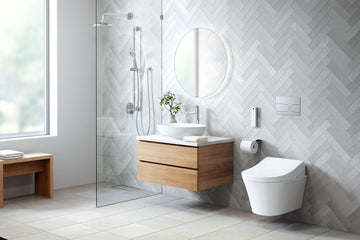In an era where eco-conscious living is at the forefront of our daily decisions, Choosing the right water-saving toilet becomes crucial not just for personal savings, but also for environmental conservation. This article will guide you through the intricacies of selecting a water-efficient toilet that aligns with your needs and helps save water efficiently.

Understanding the Importance of Water-Saving Toilets
Water is a precious resource, and the toilet is one of the household fixtures that consume the most water. An average toilet can use up to 7 gallons per flush, drastically increasing water bills and depleting water reserves. Adopting water-efficient solutions like low-flow or dual-flush toilets can significantly reduce water usage.
Types of Water-Saving Toilets
Dual-Flush Toilets: These toilets offer two flushing options a half flush for liquid waste and a full flush for solid waste. This feature alone can save an average household more than 20,000 gallons of water each year. To read more on the workings of dual-flush toilets, check out our detailed article.
Pressure-Assisted Toilets: Using air pressure, these toilets provide a powerful flush while using less water. They are best suited for high-traffic areas where efficiency is key.
Key Features To Consider When Choosing the Right Water-Saving Toilet
When it comes to selecting a water-saving toilet, there are several critical factors to consider, ensuring that the choice aligns with both functional needs and environmental goals:
Efficiency and Water Use
The key to a water-efficient toilet is its Gallons Per Flush (GPF) rate. Low-flow toilets typically use 1.6 gallons per flush or less, making them highly efficient. Skipping excessive water waste leads to notable environmental and financial savings.
Cost and Savings Over Time
Although water-saving toilets may have a higher initial cost compared to traditional toilets, the investment pays off with reduced water bills in the long-run. For instance, installing a dual-flush toilet can save between $200 to $300 annually.
Choosing efficiency over initial cost is what makes it feasible for homeowners in the long run.
Installation and Maintenance Considerations
Choosing the right toilet involves more than just the initial purchase. Proper installation and regular maintenance amplify the functional and economical benefits.
Professional Installation
Opt for professional installation to avoid potential leaks and to make sure the plumbing is adjusted for optimal water-saving performance.
Learn more about how an automatic water shut-off can be an effective accompaniment in preventing potential leaks with water-saving toilets.
Investing in the setup now can make a difference in sustained savings.
Regular Maintenance
Routine checks ensure your toilet is functioning efficiently. Leaks can be costly and should be fixed immediately. Simple maintenance checks can save a substantial amount of water and money annually.
Environmental Impact of Water-Saving Toilets
The broader impact of choosing a water-efficient toilet extends beyond personal savings. By reducing the consumption of water, we contribute significantly to the conservation efforts needed to sustain the planets limited resources.
Also, less water use leads to reduced energy consumption as less energy is needed to treat and transport water. For further understanding on conserving water, consider visiting this resource.

FAQs on Choosing the Right Water-Saving Toilet
What is a suitable GPF for water-saving toilets?
Look for toilets with a GPF rating of 1.6 or less for optimal water savings.
Are dual-flush toilets really effective?
Yes, dual-flush toilets offer two flush options based on waste type, leading to less water usage and better savings efficiency.
How much can I save with a water-saving toilet?
The savings can be significant. A dual-flush toilet, for example, can save an average household more than $200 annually, improving both financial savings and reducing environmental impact.






